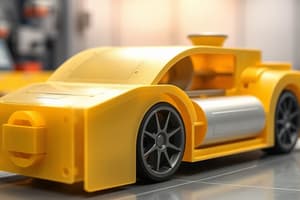Podcast
Questions and Answers
What is the primary function of Computer-Aided Manufacturing (CAM) systems?
What is the primary function of Computer-Aided Manufacturing (CAM) systems?
- To inspect and test the quality of manufactured products
- To plan, manage, and control the manufacturing process (correct)
- To assemble and package the final products
- To design and develop manufacturing equipment
Which of the following CAM systems connects multiple CNC machines to a central computer?
Which of the following CAM systems connects multiple CNC machines to a central computer?
- Robotics Control System (RCS)
- Computer Numerical Control (CNC)
- Direct Numerical Control (DNC) (correct)
- Numerical Control (NC)
What is one of the primary advantages of using Computer-Aided Manufacturing (CAM) systems?
What is one of the primary advantages of using Computer-Aided Manufacturing (CAM) systems?
- Improved accuracy and precision (correct)
- Limited flexibility in manufacturing processes
- Reduced demand for skilled personnel
- Increased production time and costs
Which of the following is a common challenge associated with implementing Computer-Aided Manufacturing (CAM) systems?
Which of the following is a common challenge associated with implementing Computer-Aided Manufacturing (CAM) systems?
What is one of the applications of Computer-Aided Manufacturing (CAM) systems in the machining process?
What is one of the applications of Computer-Aided Manufacturing (CAM) systems in the machining process?
Flashcards are hidden until you start studying
Study Notes
Computer-Aided Manufacturing (CAM)
Definition: CAM is the use of computer-based systems to plan, manage, and control the manufacturing process.
Features:
- Uses computer-aided design (CAD) data to generate instructions for manufacturing equipment
- Automates the manufacturing process, reducing manual intervention and errors
- Increases efficiency, productivity, and accuracy
- Enables rapid prototyping and production
CAM Systems:
- Numerical Control (NC): uses coded instructions to control machine tools
- Computer Numerical Control (CNC): uses computer programs to control machine tools
- Direct Numerical Control (DNC): connects multiple CNC machines to a central computer
CAM Applications:
- Machining: cutting, drilling, grinding, and milling
- Welding: robotic welding, laser welding, and resistance welding
- Inspection: computer-aided inspection and quality control
- Assembly: robotic assembly and automated assembly lines
Advantages:
- Improved accuracy and precision
- Increased productivity and efficiency
- Reduced production time and costs
- Enhanced product quality and consistency
Challenges:
- High initial investment in hardware and software
- Requires skilled personnel to operate and maintain
- Integration with existing manufacturing systems can be complex
Studying That Suits You
Use AI to generate personalized quizzes and flashcards to suit your learning preferences.


